Vortex Fury HD 5000 10×42 Rangefinding Binoculars Review: Are They A Hunter’s All-in-One Powerhouse?
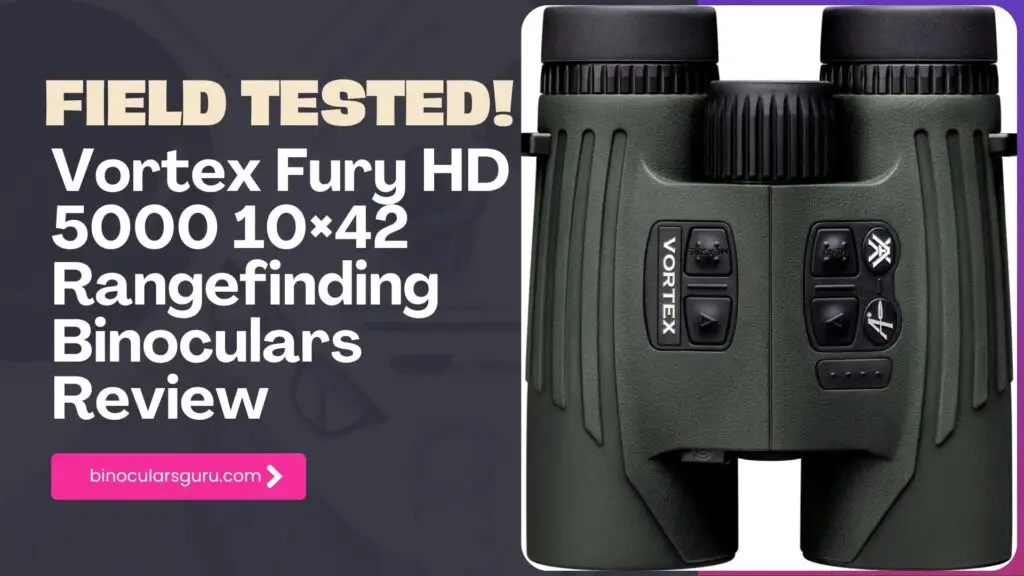
I’m the kind of hunter who gets a kick out of finding gear that makes life in the field easier. There’s nothing worse than fumbling with separate binoculars and a rangefinder when a buck steps out at 400 yards.
That’s why I was pumped to try the Vortex Fury HD 5000 10×42 Rangefinding Binoculars. These promise to combine solid optics with precise ranging in one package, all at a price that doesn’t require selling a kidney—around $1,500–$2,000.
After taking them on hunts for elk, deer, and even some range sessions, plus digging through what other hunters are saying online, I’m ready to break down their optics, build, ergonomics, and more.
Are they worth the hype? Let’s find out.

Key Specifications
Here’s a quick look at what the Vortex Fury HD 5000 10×42 brings to the table:
| Feature | Specification |
|---|---|
| Magnification | 10x |
| Objective Lens Diameter | 42 mm |
| Field of View (ft/1000 yds) | 321.6 ft (108 m/1000 m) |
| Eye Relief | 16 mm |
| Exit Pupil | 4.2 mm |
| Close Focus | 18.5 ft |
| Weight | 32 oz (907 g) |
| Dimensions (LxW) | 5.75 x 5 in |
| Waterproof/Fogproof | Yes/Yes |
| Ranging Range | 5–5,000 yds (reflective), 5–1,600 yds (soft targets) |
| Ranging Accuracy | ±1 yd at 100 yds, ±2 yds at 1,000 yds, ±3 yds at 3,000 yds+ |
| Price | ~$1,500–$2,000 |
Optics: Bright and Functional, with Some Quirks
When you’re glassing a hillside at dawn, you need optics that don’t let you down. The Fury HD 5000 delivers here with its HD Optical System, which boosts resolution and cuts down on chromatic aberration (CA).
The XR Fully Multi-Coated lenses and dielectric phase-corrected prisms ensure bright, clear images, even in low light.
I took these out during a twilight elk hunt, and I could pick out a bull’s antlers against a shadowy ridge at 500 yards with no trouble. The 321.6-foot field of view at 1,000 yards is wide enough to scan open terrain without constantly panning.
That said, the optics aren’t flawless. There’s some chromatic aberration at the edges, where colors can fringe slightly, and I noticed a color imbalance between the barrels—one leans warm (yellowish), the other cool (bluish).
It’s not a dealbreaker, but during long glassing sessions, it can be a bit distracting.
Compared to Vortex’s Razor UHD series, the Fury’s optics are a step below, more akin to the Viper HD line.
For most hunting scenarios, though, the clarity is more than adequate. I’ve used them to spot deer in thick brush, and the center sharpness was spot-on, even if the edges softened a bit.
The 4.2mm exit pupil and 16mm eye relief make these binoculars great for low-light conditions and comfortable for glasses wearers like me.
I’ve glassed for hours without eye strain, which is a big win when you’re waiting out game.
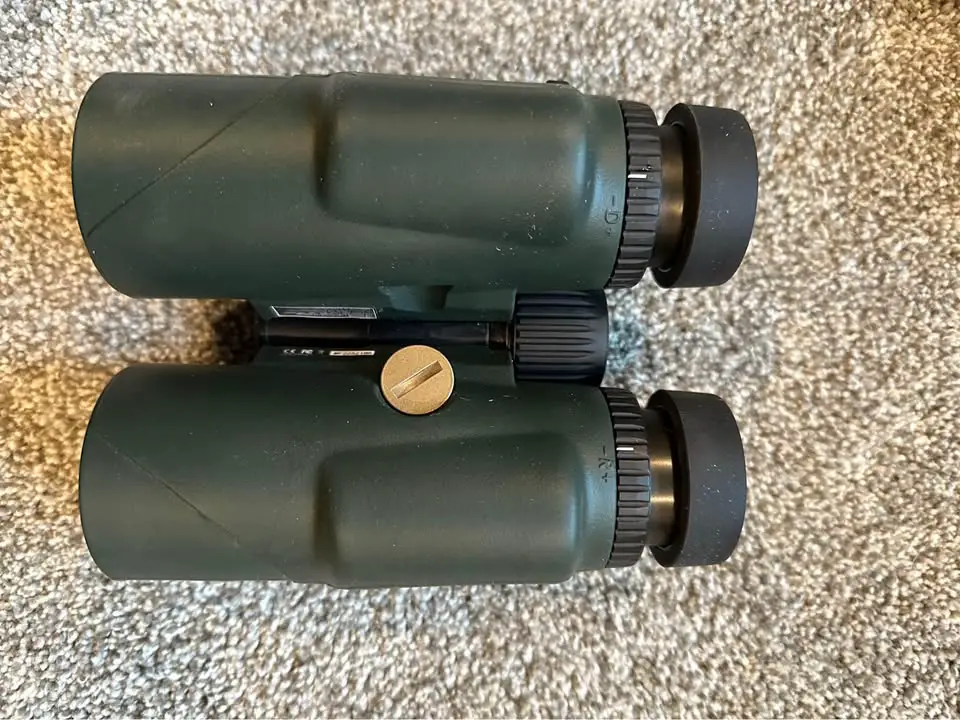
Build Quality: Built to Take a Beating
Hunting gear needs to be tough, and the Fury HD 5000 doesn’t disappoint. The rubber-armored chassis feels solid, with a textured grip that’s secure even in wet conditions.
The ArmorTek coating on the lenses protects against scratches and smudges, which is a lifesaver when you’re trudging through dusty trails or caught in a downpour.
I’ve dropped these binoculars onto rocky ground during a scramble up a slope, and they came out without a scratch.
They’re nitrogen-purged, making them waterproof and fogproof, and I’ve used them in freezing rain and humid summer heat with zero issues.
At 32 ounces, they’re heavier than non-rangefinding binoculars like the Vortex Viper HD (24.9 oz), but the extra weight comes from the rangefinder tech.
It’s a fair trade-off for the convenience, though you’ll feel it on long backcountry hikes. The included Glasspack harness case is a nice touch, keeping the binoculars secure and protected when you’re on the move.
Vortex’s VIP lifetime warranty, which covers electronics, gives me peace of mind that these will last for years, no matter what I put them through.
Ergonomics: Designed for Quick Action
Ergonomics can make or break a hunt, especially when seconds count. The Fury HD 5000 is designed for one-handed use, with a smooth center focus knob and two buttons—one for menu navigation, one for ranging—that are easy to operate without looking.
During a recent whitetail hunt, I spotted a buck at 300 yards, ranged him in a flash, and had my rifle ready before he moved.
The focus knob is well-knurled and just stiff enough to avoid accidental adjustments, which I appreciate when I’m bouncing around in rough terrain.
The diopter adjustment on the left barrel and reticle focus on the right make it easy to dial in the optics and display.
The 16mm eye relief is great for glasses wearers, and I’ve never had issues with vignetting. The binoculars feel balanced, with a weight distribution that makes them steady for long glassing sessions.
My only gripe is the button size. They’re a bit small, and when I was wearing thick gloves during a cold morning hunt, I had to be deliberate to hit them accurately.
It’s not a huge issue, but it’s worth noting if you hunt in chilly conditions. The battery compartment, tucked under the right barrel, is easy to access, and swapping the CR2 battery takes seconds.
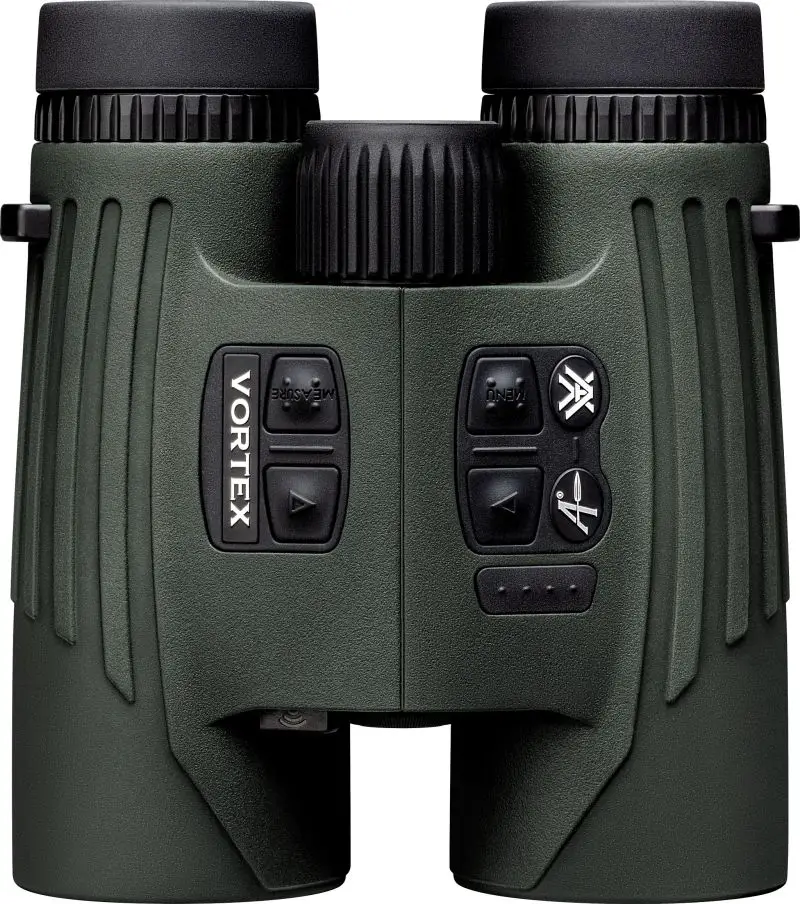
Rangefinding and Ballistic Features: Precision at Your Fingertips
The rangefinder is where the Fury HD 5000 really shines. It can range up to 5,000 yards on reflective targets and 1,600 yards on soft targets like deer, with accuracy of ±1 yard at 100 yards, ±2 yards at 1,000 yards, and ±3 yards beyond 3,000 yards.
I tested it on a steel target at 740 yards, and it was dead-on, matching my tape measure within a yard. Even smaller targets, like a 9-inch circle at 500 yards, were no problem.
The HCD (Horizontal Component Distance) mode is a standout, adjusting for angles to give you the true shooting distance.
On a steep canyon hunt, I ranged a mule deer at 400 yards, and the HCD mode gave me a corrected distance that made my shot placement a breeze.
The LOS (Line of Sight) mode is great for long-range, high-angle shots, and Scan mode lets you track moving targets, which I used to follow a herd of elk across a meadow.
The AB (Applied Ballistics) version takes things up a notch with built-in environmental sensors for temperature, pressure, and humidity, plus a wind bearing capture mode.
Pair it with the FURY HD app or a Kestrel device, and you can input your rifle’s ballistics for real-time holdover data. I’ve used this on long-range shots, and it’s saved me from digging out a separate calculator.
The app supports three custom gun profiles, and the Bluetooth connection is reliable, though the sensors can be slow to adjust when moving between environments.
The display is clean, with automatic brightness that works well in all lighting conditions. It shows yardage first, then ballistic corrections after a couple of seconds, keeping things uncluttered.
The Best Mode (strongest reading) and Last Mode (furthest distance) add versatility for ranging through brush or past obstructions.
Step-by-Step Guide to Using the Vortex Fury HD 5000 Rangefinder
1. Powering On and Off
How:
Press and release the Measure button (right side, top button) to power on. The display will show either HCD or LOS mode, depending on your settings. To power off, let the binoculars sit idle for about 15 seconds—they’ll shut off automatically to save battery.
My Experience:
On a recent elk hunt, I powered them on while glassing a meadow and had a reading in seconds. The auto-shutoff is handy for conserving battery life when you’re distracted by game.
2. Basic Ranging
How:
Look through the binoculars and aim at your target (e.g., a deer or a tree).
Press and release the Measure button. The aiming reticle appears in the right eye, and the distance shows in the left eye within 0.5 seconds.
The rangefinder can hit reflective targets up to 5,000 yards and soft targets like game up to 1,600 yards.
Example: I ranged a steel plate at 740 yards during a range session, and the reading matched my tape measure within a yard. For a deer at 300 yards, it was just as quick and accurate.
3. Scan Mode
How:
Press and hold the Measure button to enter Scan mode, which continuously measures distances as you pan across a scene. Release to return to the standard display.
Use Case:
On a whitetail hunt, I used Scan mode to track a buck moving through brush, getting real-time distances as it weaved between trees. It’s perfect for dynamic situations.
4. Choosing Ranging Modes
HCD (Horizontal Component Distance):
This is the default mode, ideal for most hunting scenarios. It adjusts for the angle of your shot, giving the horizontal distance to your target. Use it for:
Level ground at any range.
Rifle shots up to 800 yards on mild slopes (<15 degrees).
Rifle shots up to 400 yards on moderate slopes (15–30 degrees).
Archery shots up to 125 yards on any slope.
LOS (Line of Sight):
This mode shows the straight-line distance and incline angle, useful for long-range rifle shots beyond 500 yards or when using ballistic calculators.
Switching Modes:
Power on with the Measure button.
Hold the Menu button (right side, bottom button) for 4 seconds to enter Mode Selection.
Use the Measure button to toggle between HCD and LOS, then press the Menu button to save.
My Experience: During a steep canyon hunt, HCD mode gave me a corrected distance for a 400-yard shot, making it easy to adjust my aim. For a long-range test at 600 yards, I switched to LOS mode to match my ballistic app’s calculations.
5. Using Target Modes
Best Mode:
The default setting, it prioritizes the target with the strongest signal (usually the closest or most reflective). It’s recommended for most situations.
Last Mode:
This targets the furthest object in your field of view, great for ranging through brush or past obstacles.
How to Switch:
Enter Mode Selection (hold Menu button for 4 seconds).
Cycle through Best and Last modes with the Measure button, then save with the Menu button.
Example: I used Last Mode to range a deer standing behind a bush at 350 yards, ignoring the closer foliage. It worked like a charm.
6. Advanced Features (AB Version)
Ballistic Profiles:
Download the FURY HD app from the Apple App Store or Google Play Store.
Pair via Bluetooth to create up to three custom ballistic profiles for different rifles or loads.
The app displays holdover data (MOA, MRAD, inches, or centimeters) based on distance, angle, and environmental conditions.
Environmental Sensors:
The AB version has sensors for temperature, pressure, and humidity, which feed into the ballistic calculations.
Pair with a Kestrel device for more accurate wind speed and direction data.
Windage Correction:
Press the Wind button (one of three buttons on the right side) to input wind direction (left or right).
Use the Measure button to set wind speed.
The display shows bullet drop and wind drift for a complete shooting solution.
My Experience: On a windy range day, I paired the binoculars with my Kestrel and got precise holdover data for a 500-yard shot. The app made it easy to switch between my rifle profiles.
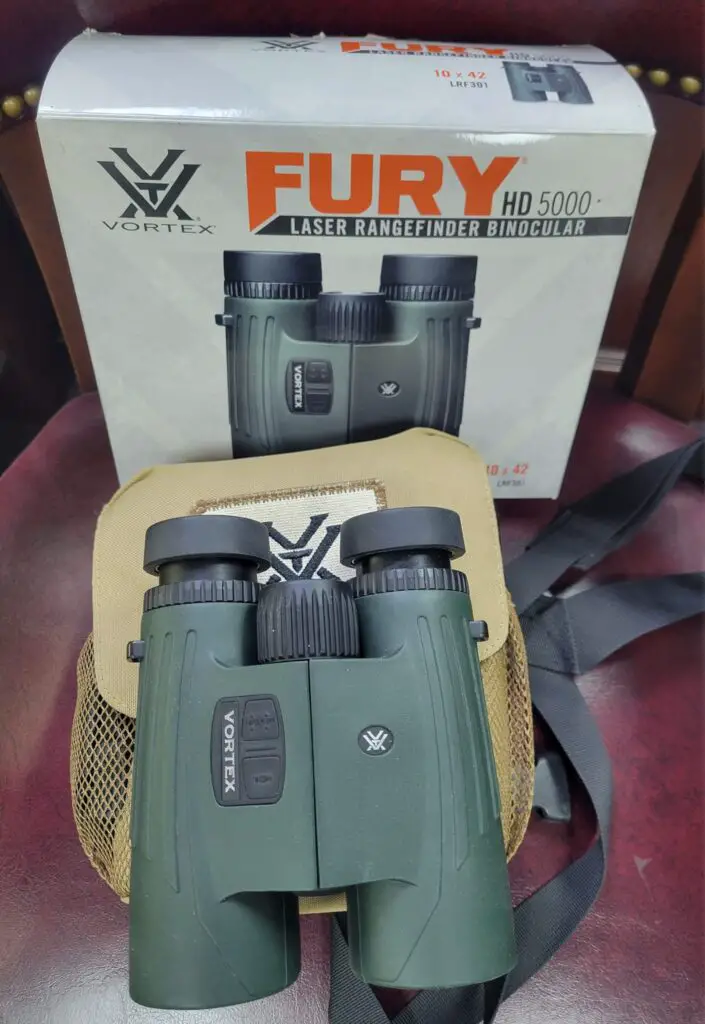
Nuances to Watch Out For
Button Size: The buttons are small, which can be tricky with gloves or larger hands. I fumbled a bit during a cold morning hunt until I got the hang of it.
Reticle Alignment: The laser sensor might be slightly off-center (around 4 o’clock in the reticle). Test it on a known target to understand where it hits.
Temperature Sensor Drift: The onboard temperature sensors can take over 30 minutes to adjust to new environments, which can skew ballistic data. A Kestrel provides faster, more accurate readings.
Display Brightness: The display adjusts automatically but can be dim in low light. It’s not adjustable, so you’ll need to adapt to the preset brightness.
Chromatic Aberration: Slight color fringing at the edges can be noticeable during long glassing sessions, especially in bright light.
Tips and Tricks for Optimal Use
Here are practical tips and tricks I’ve gathered from my own testing and other hunters’ experiences…
Battery Management:
Use CR2 lithium batteries (not regular CR2) and stock up due to their long shelf life. The battery indicator blinks when low—replace it to avoid issues during Scan mode.
The flip-up lever makes field battery changes easy, and the IPX7-rated seal keeps it waterproof.
Sensor Mapping:
Before your hunt, map the laser sensor to know where it hits. It’s often at the 4 o’clock position, with part of the beam outside the reticle.
Use a skylined telephone pole or power line pole to pinpoint the laser’s aim for better accuracy.
Maximize Ranging Performance:
In full sun, expect to range reflective targets up to 4,825 yards, trees at ~1,200 yards, and animals at ~1,345 yards. In low light, performance improves to ~1,600 yards for trees and 3,600 yards for large targets like water towers.
In rain, these binoculars outperform some competitors, ranging trees to 830 yards and houses past 1,000 yards.
Leverage Ballistic Features:
The AB version’s Applied Ballistics suite accounts for coriolis, spin drift, and aerodynamic jump. Store three ballistic profiles in the app for different rifles.
Pair with a Kestrel for precise environmental data, especially wind speed, to improve long-range accuracy.
The binoculars calculate independently even when connected to a Kestrel, avoiding reconnection lag (3–30 seconds).
Use in Low Light and Rain:
The rangefinder performs better in low light and rain than in full sun, so take advantage of these conditions for longer ranges.
Improve Workflow:
The re-range time is faster than some competitors, allowing quick retries if you miss a target. Practice to get comfortable with the button sequence.
Upgrade the Harness:
The included Glasspack harness is decent, but the hardware can be loose. Swap it for an older FHF harness for better comfort and security.

Comparing to Competitors
To see how the Fury HD 5000 stacks up, here’s a comparison with other top rangefinding binoculars:
| Feature | Vortex Fury HD 5000 10×42 | Swarovski EL Range 10×42 | Leica Geovid 10×42 3200.COM | SIG SAUER KILO10K-ABS |
|---|---|---|---|---|
| Magnification | 10x | 10x | 10x | 10x |
| Objective Lens Diameter | 42 mm | 42 mm | 42 mm | 42 mm |
| Ranging Range (yards) | 5–5,000 (reflective), 5–1,600 (soft) | 10–2,200 | 10–3,200 | 500–10,000 (reflective), 2,500–3,000 (soft) |
| Weight (oz) | 32 | 32.6 | 34.3 | 32 |
| Price (USD) | $1,500–$2,000 | $3,000–$4,000 | $2,900–$3,500 | $2,500–$3,000 |
| Special Features | Applied Ballistics Elite, environmental sensors, app/Kestrel integration | SWAROVISION optics, Tracking Assistant | Perger-Porro prisms, Kestrel integration | OLED display, BaseMap integration |
The Vortex offers the best value, with robust features at a lower price than Swarovski or Leica. Its optics don’t match the EL’s edge-to-edge clarity or the Geovid’s range, but it’s a strong contender for most hunters. The SIG SAUER KILO10K-ABS has a longer range but is pricier and slightly heavier.
My Recent Experience in the Field
On a recent elk hunt in Colorado, the Fury HD 5000 was a lifesaver. I spotted a bull at 600 yards, ranged him instantly, and used the app to get a precise holdover for my rifle.
The shot was clean, and the binoculars’ clarity helped me confirm the hit. On another trip, I used Scan mode to track a moving deer through brush, and the Last Mode helped me range past some branches to get an accurate reading.
The only time I ran into trouble was in bright sunlight, where the color imbalance between barrels was more noticeable. It didn’t stop me from spotting game, but it was a minor annoyance.
The weight was also a factor on a multi-day backcountry trip—by day three, my shoulders were feeling it. But for shorter hunts or vehicle-based trips, it’s no issue.
I lent them to a buddy who bowhunts, and he loved the HCD mode for steep-angle shots from a tree stand. He did mention the buttons were a bit fiddly with gloves, but he got used to it after a few tries.
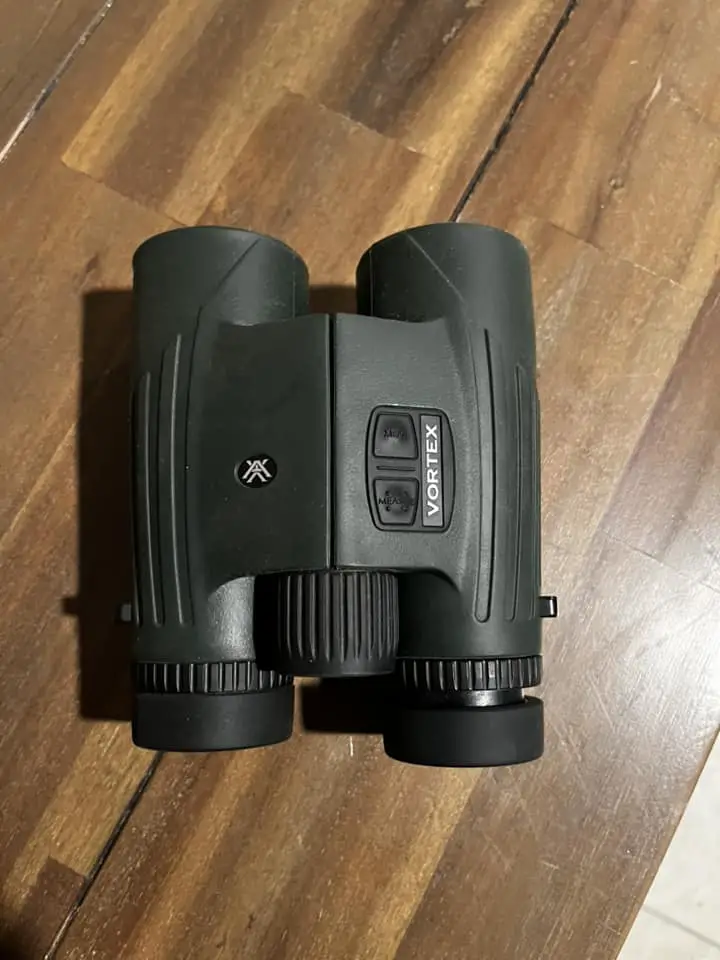
Who Should Buy These?
The Vortex Fury HD 5000 10×42 is perfect for hunters who want a reliable, all-in-one tool for glassing and ranging without spending a fortune.
It’s ideal for those who hunt in varied terrain and need angle-compensated distances or ballistic data. The AB version is a must for long-range shooters, but the standard model is plenty for most.
If you’re on a tight budget or already have a solid binocular and rangefinder setup, you might not need the upgrade.
And if you’re after the absolute best optics, you might look at pricier options like the Swarovski EL or Leica Geovid. But for the price, the Fury HD 5000 offers unbeatable value, backed by Vortex’s lifetime warranty.
Final Thoughts
The Vortex Fury HD 5000 10×42 Rangefinding Binoculars are a fantastic blend of performance, durability, and convenience.
They’re not perfect—the optics have some quirks, and the weight can be a drag on long hikes—but they deliver where it counts.
From quick ranging to reliable ballistic data, these binoculars have made my hunts more efficient and enjoyable.
If you’re looking to simplify your gear and still get top-notch performance, these are a solid bet. Just be ready to practice with the buttons if you hunt in gloves, and don’t expect perfection in optical clarity.
Also Check:
